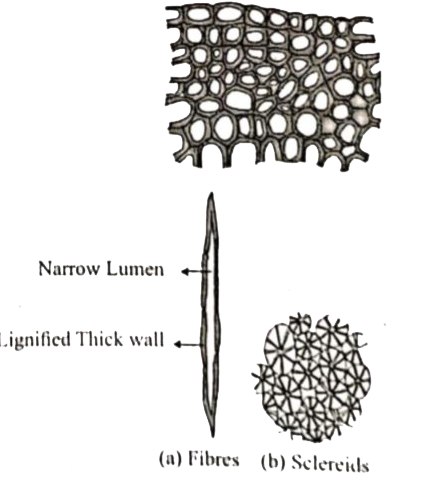What are permanent tissues? Describe the different types of simple permanent tissue. Solution in Tamil
Permanent tissues are those in which, growth has stopped either completely or for the time being At times, they become meristematic partially or wholly. Permanent tissues are of two types namely (i) simple tissue and (ii) complex tissue.
Simple tissue
Simple tissue are homogeneous-composed of structurally and functionally similar cells eg., Parenchyma, collenchyma and Sclerenchyma.
(i) Parenchyma
Parenchyma are simple permanent tissue composed of living cells. Parenchyma cells are thin walled, oval, rounded or polygonal in shape with well developed spaces among them, In aquatic plants, Parenchyma possesses intercellular air spaces, and is named as Aerenchyma. When exposed to light, parenchyma cells may develop chloroplasts and are known as Chlorenchyma.
Functions: Parenchyma may store water in many succulent and xerophytic plants. it also serve the function of storage of food reserves, absorption, buoyancy, secretion etc.
(ii) Collenchyma
Collenchyma is a living tissue found beneath the epidermis. cells are elongated with unevenly thickned non-lignified walls. Cells have rectangular oblique or tapering ends and persistent protoplast. They possess thick primary non-lignified walls
Functions: They provide mechanical support for growing organs.
(iii) Sclerenchyma
Sclerenchyma consists of thick walled cells which are often lingnified, sclerenchyma cells do not possess living protoplasts at maturity. Sclerenchyma cells are grouped into (i) fibres and (ii) sclereids.
Fibre are elongated sclerenchymatous cells, usually with pointed ends. Their walls are lignified Fibre are abundantly found in many plants. the average length of fibres is 1 to 3 mm, however in plants like linum usitatissimum (flax) cannabis sativa (hemp) and corchorus capsularis (jute) fibres are extensively longer ranging from 20mm to 550 mm.


Topper's Solved these Questions
- BOOK - FULL MARKSCHAPTER - ORGANIZATION OF TISSUES EXERCISE - EXERCISE VII. HIGHER ORDER THINKING SKILLS.2videos
ORGANIZATION OF TISSUES
- BOOK - FULL MARKSCHAPTER - ORGANIZATION OF TISSUES EXERCISE - ADDITIONAL QUESTION SHORT ANSWERS QUESTION4videos
ORGANIZATION OF TISSUES
- BOOK - FULL MARKSCHAPTER - ORGANIZATION OF TISSUES EXERCISE - EXERCISE V. ANSWER BRIEFLY:6videos
ORGANIZATION OF TISSUES
- BOOK - FULL MARKSCHAPTER - ORGAN SYSTEMS IN ANIMALSEXERCISE - ACTIVITY1videos
ORGAN SYSTEMS IN ANIMALS
- BOOK - FULL MARKSCHAPTER - PARTS OF COMPUTER EXERCISE - ADDITIONAL QUESTIONS (Long answers questions)1videos
PARTS OF COMPUTER
Similar Questions
What is the consequence that occur if all blood platelets are removed from the blood?
02:36View SolutionName the elements present in phloem.
02:06View SolutionWhat are intercalary meristems? How do they differ from other meristems?
02:38View SolutionLook at the pictures given below and answer the questions that follow :

1. Are the teeth of animals similar to ours ?
2. How is the shape of their teeth related to their food habit ?08:34View SolutionExplain the types and functions of cables.
04:36View SolutionDescribe the different types of permanent tissues.
View Solutionसरल स्थायी ऊतक किस प्रकार की कोशिकाओं का बना होता है?
05:06View Solutionसरल स्थायी ऊतक कितने प्रकार के होते है ?
02:19View Solutionस्थायी ऊतकों के प्रकार और संरचना का विवरण दीजिए। इन ऊतकों के प्रमुख कार्य क्या है?
01:47View Solutionऊतक क्या है ? विभिन्न प्रकार के सरल स्थायी ऊतक का वर्णन कीजिए।
10:37View Solutionस्थायी ऊतक किन्हें कहते हैं ? यह कितने प्रकार के होते हैं ? साधारण ऊतकों के विभिन्न प्रकारों का चित्र सहित वर्णन करो।
01:50View Solutionस्थायी ऊतक किन्हे कहते है ? ये कितने प्रकार के होते है ?
07:48View Solutionसरल स्थायी ऊतक के विभिन्न प्रकार बताइये और प्रत्येक का कार्य लिखिए|
01:31View Solutionसरल स्थायी ऊतक के विभिन्न प्रकारों के नाम लिखिए।
01:28:26View SolutionWhat are permanent tissues? To describe different types of simple permanent tissues.
02:06View Solution

